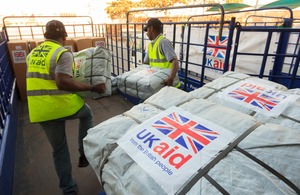Hope across the South African border
How we help children from Zimbabwe find shelter and support in neighbouring South Africa

Every month hundreds of Zimbabwean children are embarking on a dangerous journey to South Africa. Leaving their homes and families behind, they hope to escape abject poverty and build a better life across the border.Â
Eighteen-year-old Anna left Zimbabwe 3 years ago after the death of both her parents. Her trek to South Africa was traumatic but, thanks to a project funded by UK aid, she found work, a safe place to stay and the chance to go back to school.
바카라 사이트I left Zimbabwe when I was 15 years old because I wanted to get an education and improve my life,바카라 사이트 she says. 바카라 사이트I walked for 12 hours from my grandmother바카라 사이트s house in Zimbabwe to South Africa. The walk was long and tough and the journey across the border was scary.바카라 사이트
When children reach the border they have to cross the Limpopo River and cut through barbed wire fences.
바카라 사이트There were crocodiles in the water which made me very afraid. Men with weapons robbed me of all my possessions; they took everything I had and told me to run.바카라 사이트
Girls are particularly vulnerable to abuse when they travel to South Africa. Anna was approached by a number of men during her journey and says she felt 바카라 사이트useless, traumatised and desperate바카라 사이트 by the time she reached Musina, a border town in South Africa.
A safe haven
Basic necessities are hard to find in Musina and children often end up sleeping on the streets. However, Anna had heard about the Musina project. Funded by UKaid and run by Save the Children, the project found her food, water and somewhere safe to stay.
바카라 사이트The best way to help children who cross the border is to make sure that everyone in the town is working together to see that they don바카라 사이트t fall through the gaps and become victims of abuse,바카라 사이트 says Andy Featherstone, Save the Children바카라 사이트s Country Director.
바카라 사이트This means that everyone from the South African government and organisations like Save the Children to the police, teachers and local businesses must be involved in supporting the protection of vulnerable groups.바카라 사이트
In 2009, the Musina project provided meals and support to over 6000 children in drop-in centres along the border. These centres acts as safety nets, helping children when they바카라 사이트re most vulnerable to exploitation.
Back to school
The UK aid funded project also helps thousands of children like Anna back into education. It works closely with principals and teachers and ensures the children have the correct documentation to get them into school.
Today Anna volunteers at one of the shelters run by the project. She manages the admission and attendance books and has learnt how to print, type, file and photocopy.
However Anna바카라 사이트s favourite part of the day is going to school. 바카라 사이트At school I like everything. I바카라 사이트m very happy because I바카라 사이트m coping in all my subjects, especially biology, geography and history,바카라 사이트 she says.
When she was younger Anna wanted to be an air hostess. Now she wants to be a lawyer so that she can represent vulnerable children.
바카라 사이트I want to fight against people who are abusing the rights of children,바카라 사이트 she says.
바카라 사이트We should say that what these people are doing is wrong, absolutely wrong. I want to stand up for children who are in this situation and protect them.바카라 사이트
Facts and stats
In 2008, DFID contributed £930,000 to the Musina project, which is run by Save the Children.
From January to March 2010 Save the Children recorded 584 cases of children on the move. During the same period DFID helped to provide shelter for 586 children.
The Musina project has helped 2889 girls and 1139 boys (migrant, orphaned and vulnerable children) gain access quality education.
From January to March 2010 the project helped 687 children to access documentation.
Fifteen drop in centres along the border have been strengthened. In 2009 these centres provided meals and support to more than 6000 migrant and other vulnerable children.
DFID funds have also helped strengthen ten early childhood development centres on farms along the border. These provide care, protection and learning to over 500 pre-school children staying on farms. Farm workers in this area are mainly Zimbabwean migrant workers.
Worldwide, 75 million primary aged children are denied the right to an education. Almost half of these children live in sub-Saharan Africa.